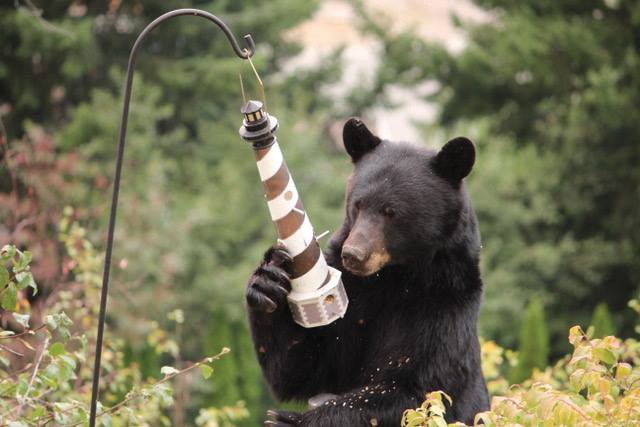Bears have begun their search for extra calories and water to fatten up before winter hibernation. WildSafeBC is reminding residents to take a thorough look around their homes and yards and put away anything that may attract wildlife.
Marina Stjepovic, WildSafeBC coordinator for the Sunshine Coast, has been out on the ground this year, advising the public about bears and other wildlife.
“Most people understand that in a community like ours with surrounding natural areas, we’re going to encounter wildlife. And they feel a sense of pride about that. But many people don’t tend to make the connection between what’s around their homes and the negative impact on wildlife. Others want to help wild animals, and believe that feeding them is a good way to do that. But it doesn’t help them in the long run.”
Most often it’s garbage and human food sources, like bird feeders, fruit trees or outdoor freezers that attract bears into our neighbourhoods. “Over time, these bears may gradually lose their wariness of humans and they tend to come too close to our homes,” Stjepovic warns. “This creates a dangerous situation for humans and wild animals. For example, a startled bear feeling trapped in a yard or among houses is more likely to attack.”
Conservation officer Nicole Caithness reports that the cool, rainy spring and delayed berry crops followed by a hot, dry summer caused local wildlife populations considerable stress. “On the Sunshine Coast we received over 400 calls regarding black bear activity, which is fairly normal, but several calls were of a serious, public safety nature, where bears either followed humans into residential areas or entered into occupied homes. In these situations, we had no choice but to remove that bear from the population in order to protect the safety of all members of the community.” She adds that in the majority of cases, these bears came into conflict due to improperly secured attractants.
In addition to food attractants, there are also non-food types of attractants such as liquid fertilizers, antifreeze or petroleum products, which are highly toxic to animals. Sgt. Dean Miller of the BC Conservation Officer Service estimates that one to three bears are poisoned each year on the Sunshine Coast. He describes a recent example where a bear was reported by the public to be sick looking. “When we trapped the bear it was foaming at the mouth and its respiratory system was shutting down. We sent the bear to the veterinarian, and testing showed antifreeze in its system.”
Some tips to help keep wildlife wild and our communities safe:
• If you have fruit trees, please don’t leave it to the bears. Pick ripe and fallen fruit daily, or arrange for volunteers to pick. Email [email protected] or call 604-999-2814. Install electric fencing to deter wildlife.
• Put garbage out on the morning of pick up day, not the night before, or take it directly to the landfill.
• For home compost, turn it regularly and mix in half brown/dry materials. Avoid grease, dairy, meat, fish products – instead take these to a composting facility (Gibsons Recycling Depot or Salish Soils).
• Keep human and pet food inside, especially at night.
• Store bird feeders until winter when bears are hibernating.
• Keep the barbecue grease-free.
• Secure antifreeze, petroleum products and fertilizers.
For more tips, check www.wildsafebc.com.
– Submitted



